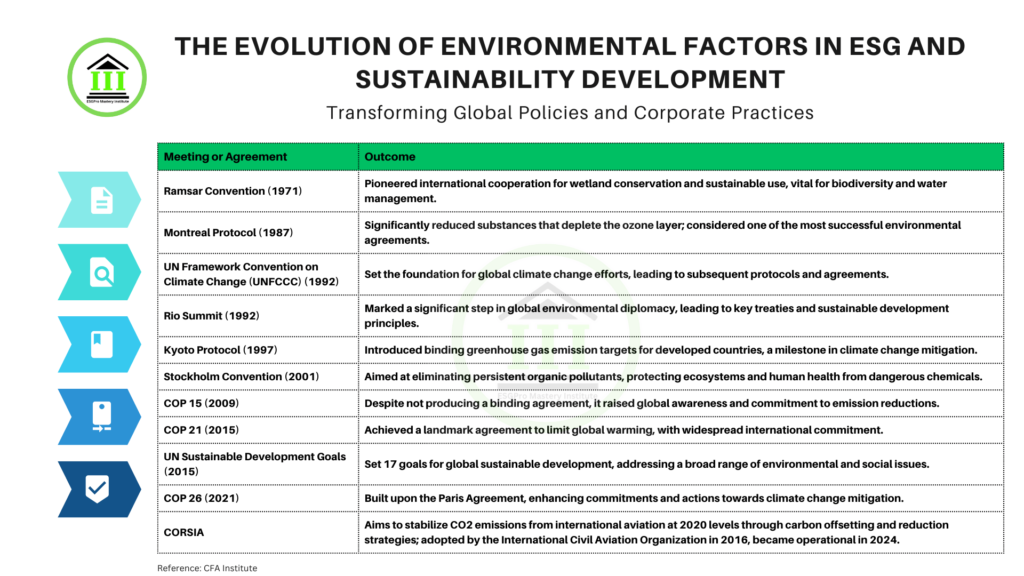The Evolution of Environmental Factors in ESG and Sustainability Development
The role of environmental factors in ESG (Environmental, Social, and Governance) and sustainability development has undergone significant transformations over the decades, largely influenced by a series of pivotal international conventions and agreements. These conventions have not only shaped global environmental policies but also profoundly impacted corporate sustainability practices and investor expectations. Here’s a detailed overview of how key international conventions have reshaped the environmental landscape:
Ramsar Convention (1971)
- Impact: As one of the earliest international treaties, the Ramsar Convention focused on wetland conservation and sustainable use, emphasizing biodiversity preservation and sustainable water management.
- ESG and Sustainability: Companies began integrating water management and biodiversity conservation into their operational strategies, laying the groundwork for future environmental regulations and corporate responsibility initiatives11.
Vienna Convention (1985) and Montreal Protocol (1987)
- Impact: The Vienna Convention established a framework for protecting the ozone layer, while the Montreal Protocol set binding targets to phase out ozone-depleting substances.
- ESG and Sustainability: These agreements drove significant changes in industrial practices, prompting companies to adopt environmentally friendly technologies and reduce harmful emissions. The Montreal Protocol is renowned for its success in international cooperation on environmental issues612.
Basel Convention (1989)
- Impact: Focused on controlling transboundary movements of hazardous wastes, the Basel Convention aimed to minimize pollution and protect human health.
- ESG and Sustainability: Companies improved waste management practices, emphasizing responsible disposal of hazardous materials and highlighting environmental stewardship4.
UN Framework Convention on Climate Change (UNFCCC) (1992)
- Impact: The UNFCCC laid the groundwork for global climate change efforts, leading to subsequent agreements like the Kyoto Protocol and Paris Agreement.
- ESG and Sustainability: It drove corporate sustainability initiatives, with companies setting emission targets and integrating climate change mitigation into business strategies7.
Rio Summit (1992) and Agenda 21
- Impact: The Rio Summit marked a significant milestone in global environmental diplomacy, leading to Agenda 21, which outlined a comprehensive plan for sustainable development.
- ESG and Sustainability: Agenda 21 emphasized integrating environmental, social, and economic dimensions of sustainability, prompting companies to adopt holistic sustainability approaches3.
Kyoto Protocol (1997)
- Impact: Introduced binding greenhouse gas emission targets for developed countries, marking a significant step in climate change mitigation.
- ESG and Sustainability: Accelerated corporate efforts to reduce carbon footprints and invest in renewable energy, setting a precedent for transparency in environmental reporting4.
Stockholm Convention (2001)
- Impact: Aimed to eliminate persistent organic pollutants (POPs), which are highly toxic and resistant to degradation.
- ESG and Sustainability: Companies phased out POPs and adopted safer alternatives, highlighting the importance of chemical management throughout product lifecycles4.
UN-REDD (2008)
- Impact: Focused on forest conservation in developing countries to reduce emissions from deforestation and forest degradation.
- ESG and Sustainability: Emphasized the role of forests in climate change mitigation and biodiversity preservation, integrating forest conservation into corporate sustainability strategies4.
Paris Agreement (2015)
- Impact: Set ambitious targets to limit global warming and accelerate the transition to a low-carbon economy.
- ESG and Sustainability: Catalyzed corporate climate action, with companies setting science-based targets, investing in renewable energy, and integrating climate risk into business strategies7.
Kigali Amendment (2016)
- Impact: Strengthened the Montreal Protocol by adding provisions to phase down hydrofluorocarbons (HFCs), potent greenhouse gases.
- ESG and Sustainability: Prompted companies to reduce HFC use and adopt more sustainable cooling technologies, contributing to global climate change mitigation efforts6.
IMO 2020 (2020)
- Impact: Imposed stricter sulfur limits on ship fuel to reduce marine pollution and protect air quality.
- ESG and Sustainability: The maritime industry adapted to stricter emission standards, driving innovation in cleaner fuel technologies and reducing environmental impact.
COP 26 (2021)
- Impact: Built upon the Paris Agreement, enhancing commitments and actions towards climate change mitigation.
- ESG and Sustainability: Reinforced global momentum towards net-zero emissions, with companies setting more ambitious climate targets and accelerating sustainability initiatives7.
CORSIA
- Impact: Aims to stabilize CO2 emissions from international aviation through carbon offsetting and reduction strategies.
- ESG and Sustainability: Driven the aviation industry to adopt sustainable practices, with airlines investing in carbon offsets and fuel-efficient technologies to reduce environmental impact.
Conclusion
The evolution of international conventions has profoundly shaped the role of environmental factors in ESG and sustainability development. These agreements have driven corporate responsibility, innovation, and transparency, emphasizing the integration of environmental considerations into business strategies. As the global community continues to address environmental challenges, these conventions serve as a foundation for collective action and sustainable development.
Share
Export
Rewrite

